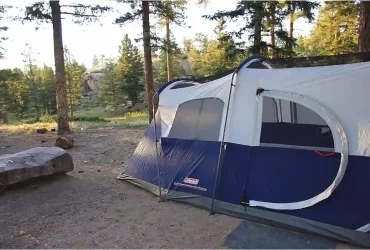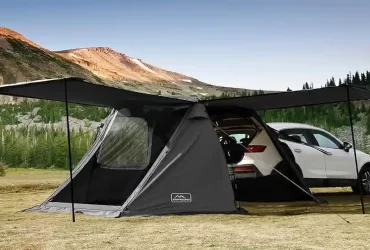If you’ve been around camping enthusiasts, you’re likely to have heard the term rain fly, but what exactly is it? Despite not being familiar with the term before, you probably know what it means. It is this (sometimes) extra piece of tent gear that can make or break your camping expedition. Best tent should be purchased by any camper who wishes to make their camping trip a success.
Rain flies are an extra piece of material that is placed over your tent. As a result of the extra waterproofing applied to the material, you can use one to protect yourself against harsh weather conditions like rain, snow, wind, and cold temperatures. For more information, read the rest of the article.
What is a Rain Fly Made of?
A rain fly can also be made from many different types of materials, including the following:

- Cotton canvas
- Cuben fiber
- Nylon
- PVC
- Polyester
- Polycotton canvas
The most common material for rain flies is polyester, followed by PVC. When camping in hardcore weather, PVC offers even greater protection. Most campers may choose polyester as the best choice. In many cases, these materials are combined with waterproofing chemicals to create rain flies that are waterproof.
Also like this:
Why do Rain Fly’s Work?
When you set up your tent, you get the main tent part, including windows, doors, poles, and material. For some tents, a rain fly may be attached to the main tent, which will cover a larger area. This extra layer may also come with its own poles or guy lines, making it even more secure. The addition of more durable and treated materials can provide your main tent with more protection from rain, snow, wind, and cold.
It is common for tent rainflies not to be attached directly to the tent. The space between the rain fly and the tent can serve as an insulating layer and even help keep the tent cool when the weather gets hot. The rain fly is often included with the tent. Rain flies of some types do not cover the entire tent, just the top. Even though these types of rain flies can protect from rain and wind, they can leak and drop in temperature as harsh weather intensifies.
It’s a good idea to purchase extra tent stakes if the tent does not already have them. Adding an additional rain fly to allow your tent to cover the entire area will protect it even more. This will make it look more attractive as well.
Pro-tip: Remember to keep it taut and tight whenever you’re using one. Using an anti-corrosive agent prevents precipitation from gathering in the cracks and folds of the material over time.
Benefits of Using a Rain Fly
In case you’re unsure whether you might benefit from a rain fly, here is a list of reasons you should consider.

- Body protection against UV rays.
- Coverage against rain is extended.
- Protecting the body from the cold.
- Wind-proof mesh for windows and doors.
- Tents and guy lines added for more stability.
- Securing your home from debris such as dirt, rocks, and sand.
Rain fly is definitely something you should seriously consider if you like this idea.
Other Common Names for Rain Flies
It may have occurred to you during your reading of this article: Wait a minute, I know that does what it does, but I never heard it called that. Rainflies, while officially called rainflies, are also known as:
- Canopy*
- Canvas*
- Cover
- Fly sheet
- Tent Fly
- Tent flap
- Tent top
If you’re buying a rain fly in the US, use the word “rain fly” as there is no serious difference between the terms. It is common to see rain flies referred to by different names around the world, but if you’re shopping overseas, use “rain fly.”
These terms have a completely different meaning when referring to tenting.
Also like this:
Conclusion
If you know what a rain fly is, then when someone asks you, “What is a rain fly?”, you will sound like an expert. Use the rain fly that comes with your tent at the very least, and if possible, purchase an even larger one.





Leave a Reply
View Comments